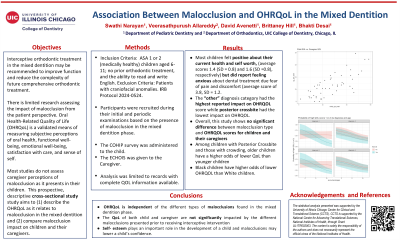Orthodontics
24 - Assessing OHRQoL and Interceptive Ortho in the Pediatric Population


Swathi L. Narayan, DDS MS
Resident
University of Illinois at Chicago, Chicago IL
Chicago, Illinois, United States- VA
Veerasathpurush Allareddy, BDS, MBA, MHA, PhD, MMSc
University of Illinois Chicago

Brittaney J. Hill, DDS, MS, MPH
Clinical Associate Professor and Residency Program Director
University of Illinois Chicago, Chicago IL
University of Illinois at Chicago
Chicago, Illinois, United States.jpg)
David M. Avenetti, DDS, MSD, MPH (he/him/his)
Pediatric Dentistry Department Head, Clinical Associate Professor
University of Illinois Chicago
University of Illinois Chicago, Dept. of Pediatric Dentistry
Chicago, Illinois, United States- BD
Bhakti Desai, DMD MS (she/her/hers)
Associate Program Director
University of Illinois Chicago 
Brittaney J. Hill, DDS, MS, MPH
Clinical Associate Professor and Residency Program Director
University of Illinois Chicago, Chicago IL
University of Illinois at Chicago
Chicago, Illinois, United States
Presenting Author(s)
Co-Author(s)
Program Director(s)
Purpose: Interceptive orthodontic treatment is recommended for malocclusions in the mixed dentition. Research explores patients’ Oral Health-Related Quality of Life (OHRQoL). This cross-sectional study aims (1) describe the OHRQoL in patients with different types of malocclusion and (2) assess differences in OHRQOL based on the type.
Methods: Surveys were distributed in a university clinic to patients and parents via Qualtrics from August – December 2024. Surveys collected sociodemographic information and orthodontic diagnosis. Parents and children completed English questionnaires: the Early Childhood Oral Health Impact Score (ECOHIS) and Child Oral Health Impact Profile (COHIP-SF19).
Results: Of the 58 surveys, 49 were analyzed (84.5% completion) The most common diagnoses were dental/ skeletal anterior crossbite (49.6%), crowding (44.9%), posterior crossbite (26.5%), and “other"(14.3%). Many children reported difficulties with eating (42.9%), pronouncing certain words (32.8%), avoiding smiling (24.5%), and bullying (24.5%) due to their teeth. Additionally, 38% of children “fairly often/always” were aware of crooked teeth/spaces, and 65.3% anticipated a feeling of confidence once treatment was completed. Parents reported that they “often” or “very often” faced financial impacts due to dental care (18.4%) and took time off work for dental appointments (30.6%). These issues encompass all types of dental care including preventive and restorative visits.
Conclusion: These findings suggest that malocclusion during the mixed dentition stage may impact self-image, while dental care poses social and economic consequences for patients and their families. Future studies will evaluate the longitudinal impact of interceptive orthodontic treatment on OHRQoL while considering covariates including caries experience and sociodemographic factors.
Identify Supporting Agency and Grant Number:

.jpg)